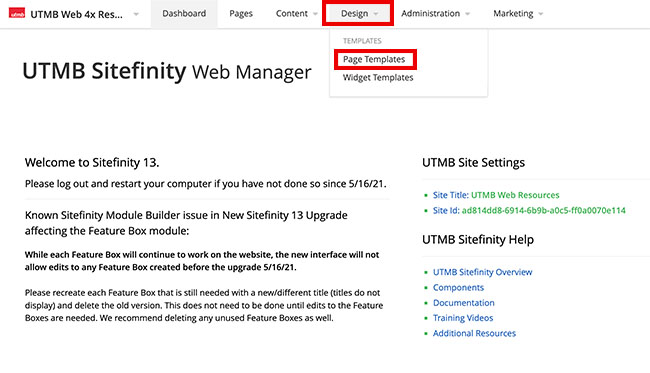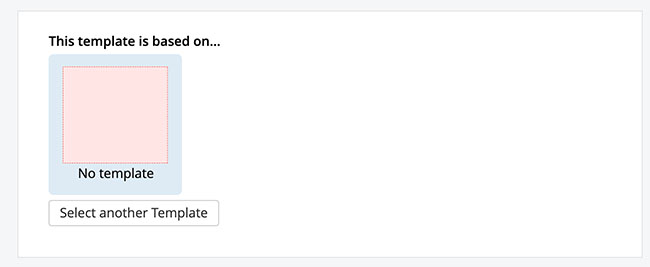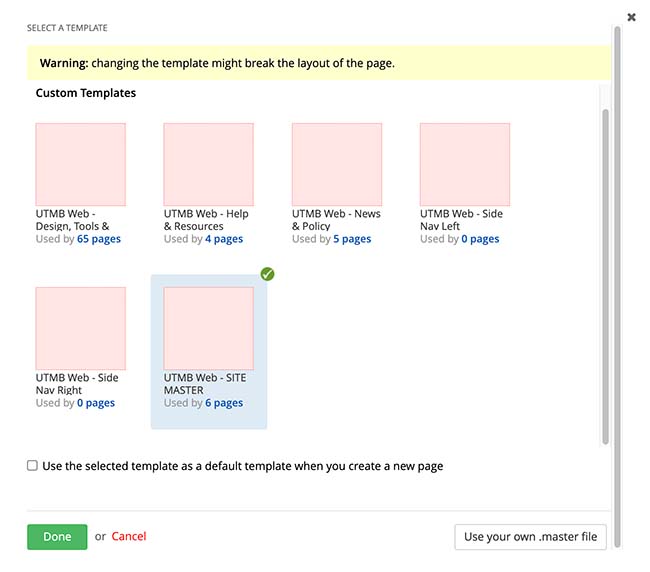Page Templates
Before you populate your page with content, you create the layout that defines how and where content is positioned and displayed on pages. For example, you may allocate space for a secondary navigation, the header, and content blocks. To do this, you use predefined or customized page templates, which you can modify further, if needed. By setting and applying the page template, you basically define the appearance and style of an individual page or all pages.
To see and manage the list of all templates that your website pages are based on, navigate to Design » Page templates.
Templates Grid
To view and manage all templates that your website pages are based on, navigate to Design » Page templates. The Templates grid provides you with details about each template, sorting, filtering, and searching options.
-
Template details
Column Description TITLE This column displays the title of the template, its status, and its thumbnail.
Click the title to open the template for editing.
By clicking the column header, you can sort the templates by the date that they were last modified.
NOTE: MVC templates have a blue label MVC on their thumbnail. .NET Core templates have a green label NEW EDITOR next to their title.
TRANSLATIONS If your site uses multiple languages, for each template, the Templates grid displays which languages the template is translated to.
BASED ON The column displays the path to the layout file or a link to an existing page template, which the template is based on.
USED IN PAGES In this column, you can see how many pages use this template.
If you click the green number, a list of all pages that use this template appears.LAST MODIFIED This column displays the date and the user that last modified the template.
By clicking the column header, you can sort the templates by the date that they were last modified.
ACTIONS By expanding the Actions menu of a template, you can:
- Edit the Content.
- Edit the title the other template properties.
- Publish a draft template
- Duplicate a template.
- Share a template with another site from your multisite instance.
- If you have multiple languages, you can send a template for translation.
- You can manage the permissions of a template.
- You can open the Revision history of a template.
- You can Delete a template after a confirmation.
-
Sort page templates
To sort page templates, on the Templates grid, click (Filter templates).
You can sort templates using the Sort templates dropdown box in the toolbar of the page.
There are the following sorting options:- Last modified on top
Sorts templates in descending order according to time of modification. - Alphabetically ascending or descending.
NOTE: You can also sort the templates, using the TITLE and the LAST MODIFIED column headers.
- Last modified on top
-
Filter page templates
To filter page templates, on the Templates grid, click (Filter templates).
You can use the following filters:- Language
If you have multiple languages, the Language dropdown box appears and you can use it to filter the template that have translation only in a selected language. - All Templates
Displays all created templates. - Filter by ownership.
To display page templates, created only by your user, click My page templates. - Translation status
- If you have multiple languages, the following filtering options appear:
- Marked for translation
Filters all templates that are is status Marked for translation. - Sent for translation
Filters all templates that are is status Sent for translation.
- Marked for translation
- Special filtering
- If you have a multisite instance, the following filtering options appear:
- This site
Filters the page templates that are shared only on the current site from the multisite instance. - Not shared with any site
If you deselect all the sites where a template is visible, you can still see the template on the Templates page by clicking this filter.
- This site
NOTE: If you have a multisite instance, except for the special filters, the filters display all templates from all sites, regardless of whether the templates are shared with the current site or not.
- Language
Create page templates
-
Page & Template Sections
Pages and templates are divided into these four main sections:
Above Page Content
- Directly below the top navigation and above the breadcrumbs
- Expands the entire width of the screen
- Common uses: alert, callout, wide images
Feature Content
- Below the above page content section
- Expands the entire width of the screen
- Common uses: Blog slider, feature boxes, wide images
Body
- The main body of the page
- Expands the entire width of the screen
- Common uses: Main content for the page or template
Base Content
- Below the body section, but above the footer
- Expands the entire width of the screen
- Common uses: this section is not commonly used

-
Create a Template
- Click the Design navigation menu item and then select Page Templates

- If the site is new, you will be provided with a 4x template that will be based on the "_UTMBWeb_4x_Hybrid" template. If the site is already established, you may see a list of templates. The default template may be based on the older 3x "UTMB_Master_MVC"
template. Please email Sitefinity@UTMB.EDU to request for the 4x template to be added to your site. Your default template should remain as basic as possible. You can create templates that are based on the default template to customize them for specific needs.

- Click the Create a template button

- Add a template name. The template name should start with the website name.

- Click the Select another Template button to select the template that this template should be based on. All templates should be based on another template.

- Select the base template and then click the Done button.

- Click the Create and go to add content button.
- Drag layout elements and/or content widgets onto the various sections.
- Click the Publish or Save Draft button when complete.
- Click the Design navigation menu item and then select Page Templates